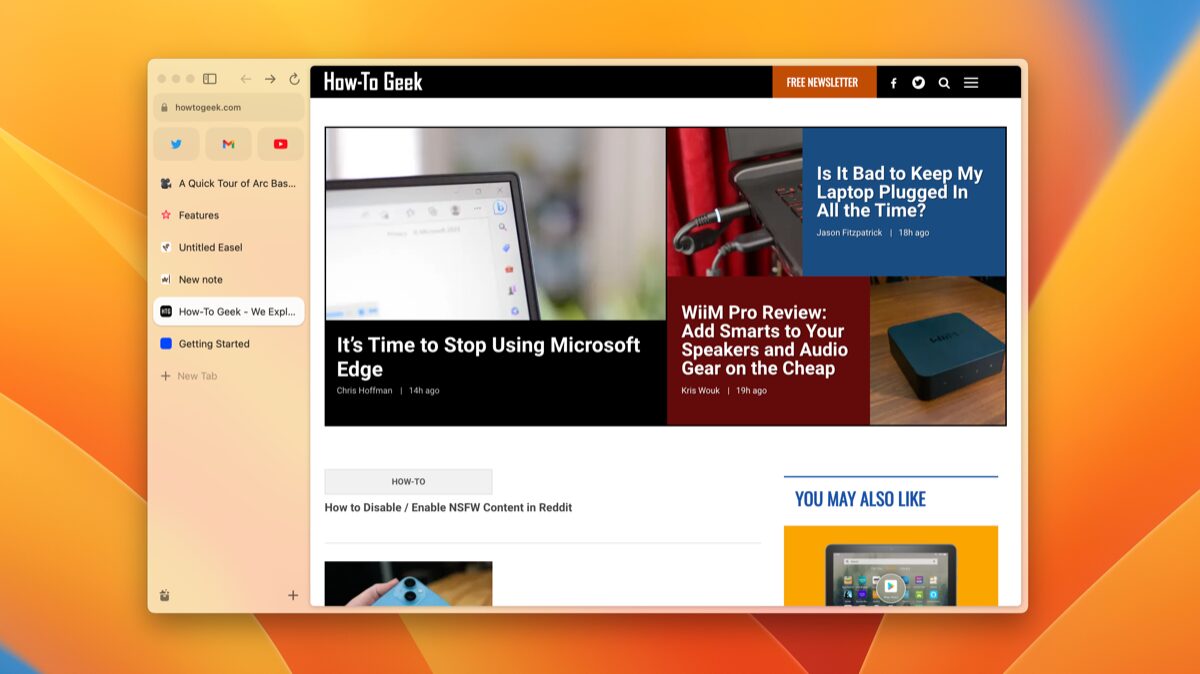How to Download and Install Older Versions of macOS
macOS
Quick Links
-
Before You Start
-
How to Download Older Versions of macOS
-
Prepare and Create a Bootable USB Drive
-
Install macOS from Scratch on Your Mac
-
Perfect for Older Apple Computers
Summary
- You can download old versions of macOS from the Mac App Store or as direct downloads from Apple’s website.
- Create a bootable USB drive using the installer Application and a few Terminal commands so that you can install the older version on your Mac.
- Boot your Mac using the USB drive and erase your system partition, then follow the instructions to install the older version of macOS.
Got an old Mac and want to reinstall macOS? Maybe you want to roll back your Mac to an earlier version of macOS than the one you currently have installed? Here’s how you downgrade macOS to an older version.
Before You Start
It’s important to understand that not all versions of macOS (or Mac OS X) work with all hardware configurations. It’s common knowledge that new macOS releases often drop support for older hardware, but the same is true for newer Mac models and older software, too.
For example, you cannot install any version of macOS that’s older than the one that shipped with your Mac. So if you buy an M4 MacBook Pro (released in 2024), you’re limited to macOS 15 Sequoia or later. There simply isn’t support in the older versions for newer hardware models that didn’t exist at the time of release.
If you’re not sure what your Mac came with, head to Apple Support and search for your exact model to find its year of release. You can find out which Mac you have by clicking on the Apple logo in the top-left corner and selecting “About This Mac.” You can then cross-reference the year of release with which version of macOS was current at the time.
If you’re willing, you can install newer versions of macOS than your Mac supports with tools like OpenCore. After trying this, you might come to the conclusion that newer releases perform too poorly on your hardware, at which point, you’ll need to roll back.
The good news i that you can roll back to almost any (supported) version of macOS. If you do decide to try a new version of macOS and you’re reliant on Time Machine for your backups, resist backing up with Time Machine until you’re sure that it’s where you want to stay.
Older versions of macOS might experience problems restoring from Time Machine backups made on subsequent releases. For example, trying to restore a Time Machine backup made in macOS Sequoia (released in 2024) to macOS Sonoma (released in 2023) could prove difficult.
You can get around this by using a third-party Mac backup tool like Carbon Copy Cloner or ChronoSync. As a last resort, you could manually back up your important documents, libraries, and so on to an external drive. We’d recommend test-driving any experimental macOS installations for a while before you commit.
How to Download Older Versions of macOS
You can download most older versions of macOS using the Mac App Store or direct links to Apple’s website. Unfortunately, Apple doesn’t index the Mac App Store entries so that you can search for them in the app. To get them, you’ll need to follow direct links, which we’ve listed below.
If you have trouble getting these links to work, first, make sure that you’re using Safari, and then try closing the Mac App Store and clicking on the link again.
Most macOS versions can still be found on the App Store using the following links:
- macOS Sequoia (2024)
- macOS Sonoma (2023)
- macOS Ventura (2022)
- macOS Monterey (2021)
- macOS Big Sur (2020)
- macOS Catalina (2019)
- macOS Mojave (2018)
- macOS High Sierra (2017)
Once your Mac App Store download finishes, do not open the installer to begin the installation. Leave the installation app in your Applications folder.
Older versions of the operating system can be downloaded from Apple directly, except for OS X Mavericks (which we can’t find anywhere):
- macOS Sierra (2016)
- Mac OS X El Capitan (2015)
- Mac OS X Yosemite (2014)
- Mac OS X Mountain Lion (2012)
- Mac OS X Lion (2011)
Once your direct download finishes, mount the DMG file and run the PKG installer within. This will put an installation app in your Applications folder, which you should leave there.
Apple no longer sells older physical versions of OS X on its website, but there might be old copies of Lion, Mountain Lion, and even Snow Leopard for sale on sites like eBay (just avoid those “3-in-1” style bootable USB drives).
Some archival websites might offer old versions of OS X for download, but we recommend you tread carefully. There’s a small chance the installer will contain malware, which could put your security at risk. And then there are the legal ramifications of downloading and distributing software that is still under copyright,.
Prepare and Create a Bootable USB Drive
You’ll need to create a bootable USB drive to install an older version of macOS. You can use this drive multiple times in different machines, throw it in a drawer for next time, or erase it when you’re done and make a new one when it’s time to reinstall again.
Apple recommends a USB drive that’s formatted as Mac OS Extended, with 14GB of free space for the latest versions of macOS. We’ve used 8GB drives in the past to install Catalina and earlier, so your mileage might vary.
To format your drive, connect it to your Mac, and then launch Disk Utility (You can do this by using Spotlight or by finding the app in your Applications > Utilities folder.). Locate the drive in the sidebar, click on it, and then click “Erase” and give it a name. In the drop-down box, select “Mac OS Extended (Journaled),” and then click “Erase” to start the process.
Give it a label like “macos_installer” to make this next part easier.
We’ll be using Terminal to create the USB drive, so launch it via Spotlight or locate the app in your Applications > Utilities folder. You can use a single command to create your installation medium, but this differs depending on which version of macOS you’re trying to install.
This assumes that you’re installing macOS Sequoia and that your drive is labeled “macos_installer,” and that you have the relevant macOS installer in your Applications folder:
sudo /Applications/Install macOS Sequoia.app/Contents/Resources/createinstallmedia --volume /Volumes/macos_installer
You can change various parts of this command to suit your own circumstances, with the main one being the name of the installer. Be aware that any spaces will need to be preceded by a backslash. For example, “Install macOS High Sierra.app” would become
Install macOS High Sierra.appHere’s another example that creates a macOS High Sierra install USB on a drive named “MacOS Installer”:
sudo /Applications/Install macOS High Sierra.app/Contents/Resources/createinstallmedia --volume /Volumes/MacOS InstallerYou can run the following command to list all connected volumes, which will include your USB installation medium in case you need to check the label:
ls /Volumes/
Once you hit Enter, you’ll need to enter your admin password to approve the command, and then hit “Y” on your keyboard to confirm that you’re OK with the contents of the USB drive being overwritten.
Install macOS from Scratch on Your Mac
Once your installation files have been copied, it’s time to install macOS from scratch. To ensure that everything goes smoothly, we’ll take the extra step of deleting your existing partition before installing macOS.
First, insert your USB drive and turn off your Mac. The next instruction will differ depending on which model of Mac you have. They are as follows:
- Apple Silicon (M1 chip and newer): Press and hold the power button until you see the startup options window, and then click on the USB volume that you created earlier and click Continue.
- Intel-powered Mac: Press and hold Option (Alt) as you turn your Mac on. Release when you see a list of bootable volumes, select the USB stick that you created, and click on the upward-pointing arrow.
Once macOS loads (You might need to select a language first.), click on Utilities > Disk Utility. Select your drive (usually labeled as “Macintosh HD”) in the sidebar, and then click “Erase.”
The contents of your Mac’s system volume will be erased in the next step, so make sure that you’ve backed up any data that you don’t want to lose.
If you’re installing macOS Sierra or later, choose “APFS.” Otherwise, you’ll need to format to “Mac OS Extended (Journaled)” for El Capitan and earlier. When you’re sure about your decision, click “Erase” and confirm.
Finally, quit Disk Utility and select “Reinstall macOS” or “Install macOS” (or Mac OS X, for older versions) from the macOS Utilities window. Follow the rest of the prompts to finish the installation.
Perfect for Older Apple Computers
You might be interested in doing this if you have an older Mac that isn’t compatible with the latest version of macOS that might still benefit from a clean installation.
Alternatively, you can factory reset modern Mac models with an M1 chip or later. This will maintain the current version of macOS, but restore the computer to an “as new” state. This is ideal if you’re selling or donating your Mac.


















